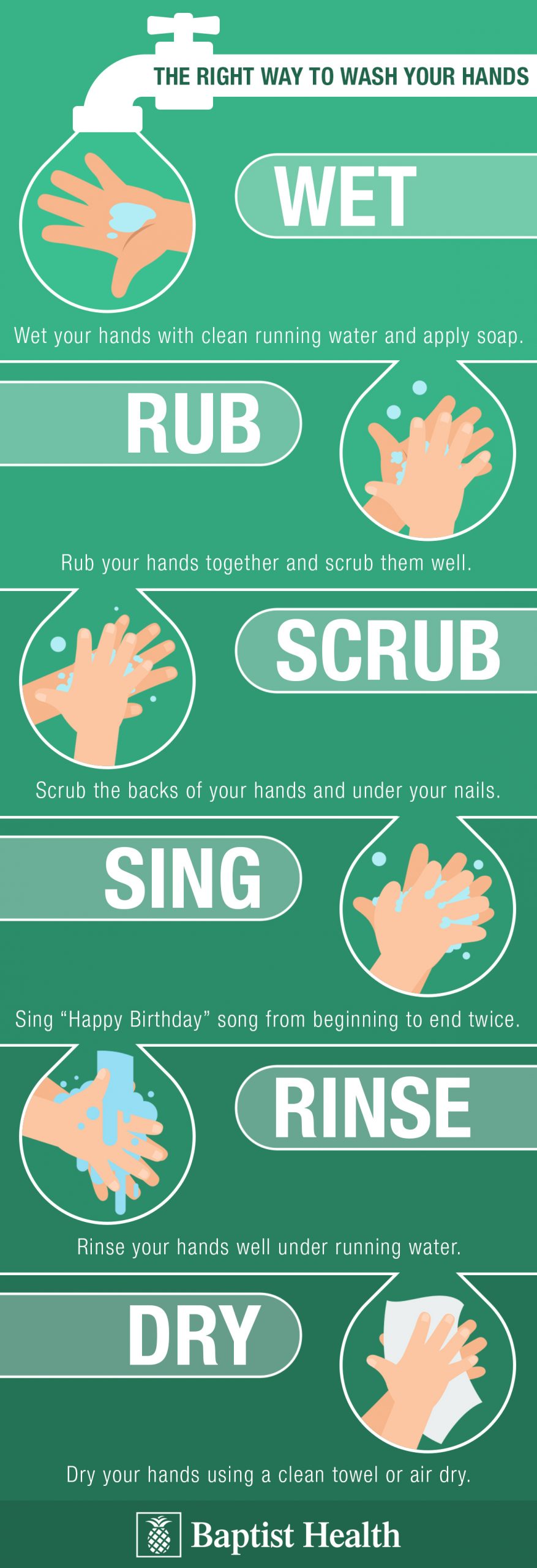April 7, 2020 by John Fernandez
Infection Protection: Frequent, Proper Handwashing is Vital

Frequent handwashing is one of the best ways to avoid getting sick and spreading the flu and other illnesses. As the U.S. braces for community outbreaks of the coronavirus illness, COVID-19, handwashing and other precautions are key steps everyone can take to avoid infections.
Soap and water are best for killing viruses on your hands. For the most effective cleansing, wash your hands for 20 seconds, which is about how long it takes to sing the Happy Birthday song twice. (See the infographic below for the proper way of washing your hands.)
Keep in mind that viruses and bacteria can live for several hours on hard surfaces such as cafeteria and restaurant tables, telephone receivers, computer keyboards and doorknobs. And you can become infected with respiratory illnesses if you don’t wash your hands before touching your eyes, nose, or mouth.
Person-to-Person Spread
The U.S. Centers for Disease Control and Prevention (CDC) says that viruses spread mainly from person-to-person:
- Between people who are in close contact with one another (within about 6 feet)
- Via respiratory droplets produced when an infected person coughs or sneezes.
- These droplets can land in the mouths or noses of people who are nearby or possibly be inhaled into the lungs.
It’s also possible that a person can get COVID-19 by touching a surface or object that has the virus on it — and then touching their own mouth, nose, or possibly their eyes. However, this surface-originating method is not thought to be the main way the virus spreads, the CDC says.
“Protection tips for the public now are basically the same as the basic steps to take during the flu season,” said Anexis Lopez, R.N, manager of Infection Control at Doctors Hospital, part of Baptist Health South Florida. “Wash your hands with soap and water, and use hand gels and sanitizers if they’re available as well. If you’re next to somebody who is coughing or sneezing, get away from them and then wash your hands well. And if you’re traveling, you really need to protect yourself.”
CDC Face-Mask Guidelines
The CDC does not recommend that people who are well wear a face mask to protect themselves from respiratory diseases, including COVID-19.
Face masks should be used by people who show symptoms of COVID-19 to help prevent the spread of the disease to others, or people who have cold or flu-like symptoms. The use of face masks is also vital for healthcare workers and people who are taking care of someone in close settings (at home or in a health care facility), the CDC says.
Experts caution that putting on a face mask that doesn’t properly fit, or handling it improperly, could actually increase risk of infection.
“If it’s not fitted right, you’re going to fumble with it,” explained U.S. Health and Human Services Secretary Alex Azar before a House Appropriations subcommittee last week. “You’re going to be touching your face, which is the No. 1 way you’re going to get disease, is unclean hands touching your face.”
Hand Sanitizers
Proper handwashing with soap and water is more effective at killing germs than hand sanitizers, even those that are alcohol-based. Hand sanitizers may not be as effective when hands are visibly dirty or greasy.
Some data show that hand sanitizers may work well against certain types of germs on slightly soiled hands. However, the CDC states, “hands may become very greasy or soiled in community settings, such as after people handle food, play sports, work in the garden, or go camping or fishing.” When hands are heavily soiled or greasy, hand sanitizers may not work well. Handwashing with soap and water is recommended in such circumstances.
When should you wash your hands? The CDC recommends handwashing:
- Before, during, and after preparing food; and before eating food
- Before and after caring for someone who is sick
- Before and after treating a cut or wound
- After using the toilet
- After changing diapers or cleaning up a child who has used the toilet
- After blowing your nose, coughing, or sneezing
- After touching an animal, animal feed, or animal waste
- After handling pet food or pet treats
- After touching garbage
Infographic by Irina de Souza

top stories












There are no comments